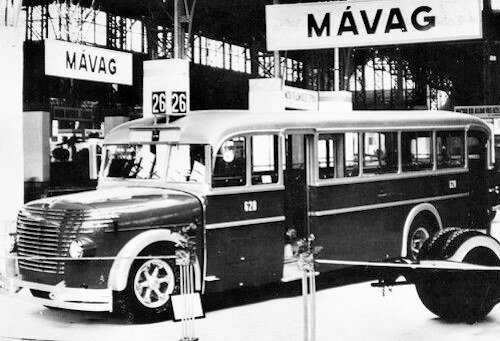MÁVAG History (Magyar Királyi Államvasutak Gépgyára)

Magyar Királyi Államvasutak Gépgyára, short MÁVAG was a Hungarian locomotive and wagon factory owned by the Kingdom of Hungary that built Commercial vehicles and Cars. After the Second World War MÁVAG was nationalized and the addition "Királyi" (Royal) was deleted from the company name.
History
The factory was located in the 8th district of Budapest, adjacent to the streets Kőbányai, Hungária, Vajda Péter and Orczy. It was next to Ganz & Cie the most famous Hungarian machine factory in the 19th century. MÁVAG became known above all for its steam locomotives produced from 1873 onwards. For the millennium of Hungary in 1896 MÁVAG delivered the 1000th locomotive to the Hungarian state railway MÁV. Engineers of the company played a decisive role in the development of electrical engineering. Károly Zipernowsky, Miksa Dériand Ottó Titusz Bláthy brought the transformer to series maturity in 1885. Kálmán Kandó introduced the railway operation with three-phase current in 1900/1902 they also supplied parts for the postal parcel delivery vehicle completed in 1905. After 1924 MÁVAG built the famous locomotives of the MÁV class 424.
In the interwar period after the First World War: the assembly of Austro-Fiat licensed trucks previously manufactured by Ganz-Fiat continued. In 1925, an agreement was made with MAG, according to which the trucks and their engines would be manufactured jointly. MÁVAG produced trucks, trolleybuses, buses and automobiles MÄVAG produced the chassis and raw material for the engines, while MAG performed the task of assembling the engine. Later In 1926, they bought the license to manufacture commercial vehicle chassis made by the German Neue Automobil-Gesellschaft (N.A.G). Four truck types chassis began to be produced four-ton and six-ton bus chassis, three-ton and five-ton trucks all with a six-cylinder engine. Mercedes-Benz also produce commercial vehicles in the 1920s at the Benz plant in Gaggenau. In 1927, Mercedes-Benz's had a new range of trucks MÄVAG purchased the license for the range with new MÄVAG-Mercedes buses. MÄVAG-Mercedes commercial vehicles continued into the 1930s to this end, 1936 Ford acquired a license for the production of the Ford Eifel and in 1939 the Ford V8 according to industrial protection laws, rental cars could only be purchased from a domestic manufacturer -
however, there was no domestic car factory. The MÄVAG-Ford collaboration lasted until the Second World War. During the Second World War In 1938, MÄVAG was commissioned by the military to produce a prototype of an all-terrain truck, tanks and other war material were made. These included the licensed production of the Italian Reggiane Re.2000, as well as their MÁVAG own development Hejja II.
After the war, MÄVAG resumed car production of essentially the pre-war earlier Mercedes Benz models.
